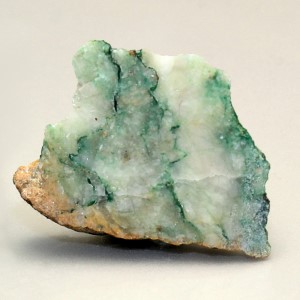»Mariposite dolomite« is a white stone with green striationss. It occurs in different places in the Sierra Nevada in California (USA), for example around Coulterville in Mariposa County. Benjamin Silliman Jr. named the stone after this region in 1868. Its occurrence is linked to a contact zone of argillaceous schists and ultrabasic rocks. Therefore dolomite and quartz coexist together with green phyllosilicates. These silicates are in a large part mariposite (a chrome-muscovite mica) but sometimes also of nickeliferous chlorite.
Minerals of the mica group are classified in white micas and dark micas depending on their appearance. Muscovite is a common member of the white mica group. The pure mineral is colorless and transparent. Variations in its chemical composition modify its physical properties (e.g. flexibility, color). Such varieties bear their own names like »Fuchsite« for a chrome mica or »Phengite« for SiO2 rich mica and »Mariposite« which is rich in chrome and SiO2. Sometimes Mariposite is also called »Chromium phengite« because of it's high content of chrome and SiO2.
The genesis of mariposit is associated with low grade metamorphic, hydrothermal activities which transform preexisting serpentinite rock into carbonate minerals (calcite, dolomite, magnesite) and sheet silicates (mica, chlorite). Stones with a comparable mineralogical composition are also called »Listwanite« (or listvenite, listvanite, listwaenite) after the location of their deposit in Kazakhstan. They are appreciated as decoration stones used for handcrafts. But they also have significance in prospecting for gold as they are said to be excellent keystones for gold deposits.




